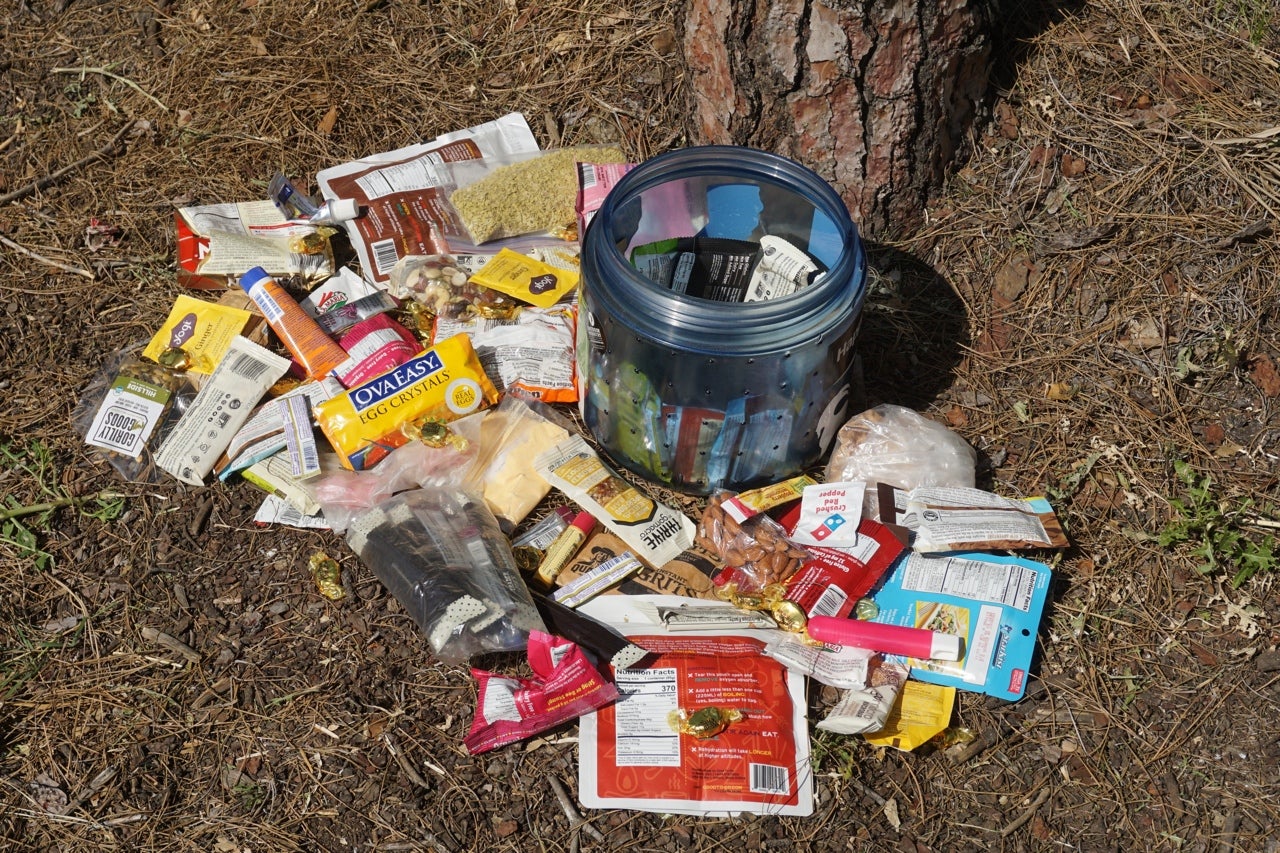Choose Wisely
Selecting your bear-frustration vessel wisely will keep it from turning into a human frustration vessel. Make sure it will fit in your pack in a well-balanced fashion (positioned against the center of your back, instead of banging against the back of your head), and that it will hold all the edibles and smellables you want to tote into the backcountry, minus that day’s food, since you’re going to scarf it all down before bedtime, in theory. Don’t wait until it’s go-time at the trailhead to figure out whether or not everything fits. Practice packing it at home. Take it from me: I’ve known the terror of finishing dinner only to realize I need to shovel down even more food because I can’t squeeze everything back inside a too-small canister.

Minimize
While it’s not uncommon to see thru-hikers carrying entire plastic jars of peanut butter, it’s better on shorter trips to bring smaller quantities in order to save space. Use travel-sized toiletries, portion out spices, oil and sauces into tiny containers, choose powdered versions of cheese, milk and butter, and funnel your favorite libations into soft flasks instead of the metal kind. Dirtbag pro-tip: While it’s possible to buy mini versions of almost anything online, you should also keep an eye out for condiment packets when visiting fast food restaurants, shopping mall food courts and coffee shops—and always make sure to ask for extra parmesan cheese or red pepper flakes when ordering pizza. Two birds, one tasty stone.
Repackage
Don’t try to fit the square (foil) peg into the round (polycarbonate) hole. Repackage things to make them more malleable, and to reduce the waste you’ll need to pack out later. If you love store-bought freeze-dried or dehydrated meals, transfer them from the standard-issue thick (read: space-sucking) foil packet to a zip-top freezer bag, and either write or tape the instructions onto that bag. This works with just about any food that comes with excess packaging. You might even keep one bag for reheating all of your food; just rinse it in between meals. Yes, things are going to get a bit crushed with this method, but trust me: Pringles are just as much of a delicious salt bomb in crumb format.
Let The Air Out
If you’ve ever spent time up high, you’re probably familiar with the phenomenon of “altitoots,” the gassy consequence of air pressure changes. And while you’re breaking wind up the trail, your food packaging is having a similar, albeit less stinky experience. A simple space-saving solution is to use a safety pin to poke a tiny hole into pre-sealed bags of stuff, like chips or ramen, to let the air out. Then reseal it with a tiny bit of tape if you’re not going to eat the contents right away. Of course, if you’re looking for a reason to blow more money on gear, consider investing in a vacuum sealer. This not only offers you the freedom to repackage damn near anything into a shrink-wrapped delight, it also allows you to save money over time—and impress your friends)—by creating individual packets of things like peanut butter and trail mix.

Think Spatially
Since I made a horrible, pudding-filled mistake the first time I used a bear canister, I’ve become a bit obsessed with perfecting the art of cramming things inside of one. The goal is not just to fill in all the space with tasty stuff, but also to do so efficiently. Carrying tortillas or other flat items? Start with those on the bottom, then line the sides with bars or any semi-rigid items like tuna packets. I usually slide my drink mix tubes in between these to form an impenetrable fence of yum, then begin filling in the middle of the canister with the squishiest, most malleable stuff first, like oatmeal, grits, rice or powdered milk. While working, I shove individually wrapped candies into any remaining crevices. You’ll hear of people dumping things like M&Ms in to fill air pockets, but I’ve seen the melted carnage, so don’t do this unless you want to play a perpetual game of “Is that chocolate, mud, or poop?” every time you pull something out of your canister. I save space on top for the next morning’s breakfast, as well as any scented toiletries. Side note: Used tampons, toilet paper, menstrual cups, and so forth should not go into your canister – bears aren’t interested in munching on this stuff, so it doesn’t need to be contained in your personal Food Knox.
Congratulations, you’re now a graduate of Bear Can University! Go forth and commence with summer trip planning knowing that you have the skills to not only properly pack a bear canister, but also to help keep our ursine pals safe from developing a harmful junk food addiction!
